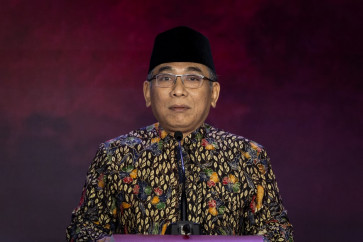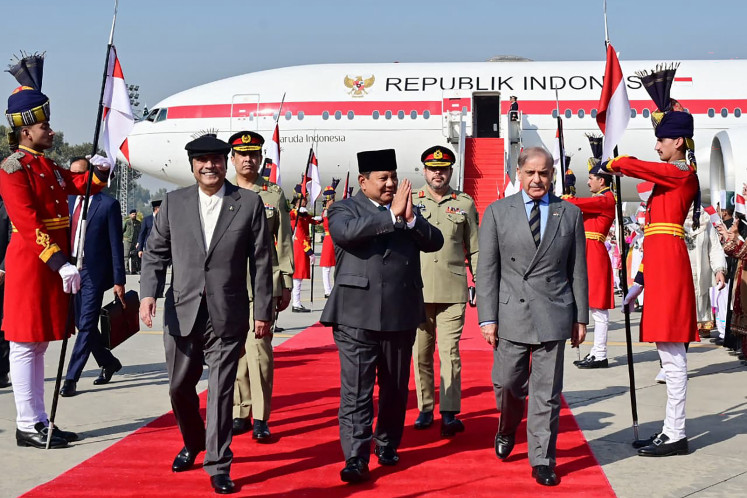Popular Reads
Top Results
Can't find what you're looking for?
View all search resultsPopular Reads
Top Results
Can't find what you're looking for?
View all search resultsBudget efficiency contrast in ASEAN: Tales from Indonesia and Vietnam
The Indonesian government is carrying out massive budget efficiencies. At almost the same time, Vietnam is also doing the same thing. What is the difference between the two?
Change text size
Gift Premium Articles
to Anyone
P
resident Prabowo Subianto is cooking up a storm to fulfill his political promises, which include his flagship free nutritious meals program, food security, energy security, housing and defense. The cost is high, and massive budget cuts to prioritize these government programs are already underway.
Around the same time, neighboring Vietnam has also trimmed its national budget. However, there is a stark contrast in how efficiently the two countries are implementing their budget cuts.
To reduce spending, Vietnam cut red tape and streamlined its ministries and state agencies. The country has merged and reduced its ministerial-level institutions from 30 to 22. It also plans to gradually cut its civil service workforce by 20 percent over five years.
Meanwhile, Indonesia’s number of ministries and state institutions has ballooned to 53, up from 34 during the previous administration. In addition to multiple deputy ministers, the government has also appointed special staffers and envoys. Some of these high-level appointments are influencers with unrelated backgrounds, raising further questions.
Here, we highlight Vietnam’s strategic approach to budget cuts, particularly regarding research funding, and explore how its strategy differs from Indonesia’s.
Vietnam does not have a single supreme ruler. The country is officially led by four key pillars of government: the party chairman, the president, the prime minister and the speaker of parliament. The Secretary-General of the Communist Party of Vietnam, To Lam, is currently regarded as the most influential figure in Vietnam.
In early December 2024, To Lam announced plans to boost state budget efficiency. Just a few months later, on Feb. 18, the National Assembly of Vietnam approved his proposal.
Vietnam’s budget cuts aim to support its economic growth target of at least 8 percent this year, the same as Indonesia’s. The government is prioritizing several sectors, including artificial intelligence development, the digital economy and renewable energy.
To help meet this target, To Lam has recommended raising the science and technology budget to 3 percent of total government spending in 2025, with further increases promised over the next five years.
The Vietnamese government has also issued Politburo Resolution 57 to accelerate research by streamlining bureaucracy, boosting research and development spending from 0.4 percent to 2 percent of GDP, and aiming to produce 12 researchers per 10,000 people by 2030.
To drive transformative research and innovation, Vietnam is also working to improve the welfare of researchers and engineers, displaying seriousness and commitment in developing the quality of its human resources.
To Lam’s ambition is to place Vietnam among the top-three countries in Southeast Asia for digital competitiveness and e-government development, and to enter the world’s top-30 countries leading in digital innovation and transformation by 2045.
Budget efficiency is part of a longstanding strategy to advance Vietnam through research and technology development. A key milestone in this journey was the successful launch of the super mini Pico Dragon satellite, designed by Vietnamese engineers and researchers from VNREDSAT-1, in August 2013. The event marked Vietnam’s growing rise in research and technology, and the country has consistently prioritized this sector ever since.
In 2017, for instance, Vietnam tasked the Ministry of Science and Technology with developing the Science, Technology and Innovation (STI) and Socio-Economic Development Strategy (SEDS) for the 2021–2030 period.
These policies have had a tangible impact, attracting investment from major global research and technology companies. Since 2017, Apple has been actively working with local manufacturing partners such as Foxcomm and Luxshare. As a result, since 2020, Vietnam has become a strategic hub for Apple’s production and supply chain.
Most recently, Nvidia, the United States multinational technology giant, officially invested in Vietnam at the end of 2024. In partnership with local tech firm FPT, Nvidia will establish an AI research and development center in the country. It is no surprise that Vietnam is now soaring as a cutting-edge research and technology hub, thanks to strong backing from both the government and the private sector.
In contrast to Vietnam, Indonesia’s National Research and Innovation Agency (BRIN), the government body responsible for driving research and technological innovation, has become one of the immediate victims of significant budget cuts.
Initially, BRIN proposed a reduction of around Rp 2 trillion (approximately US$120 million) from its total budget proposal of around Rp 5.8 trillion. Under this scheme, BRIN’s remaining budget would barely cover employee salaries of around Rp 3 trillion, leaving just Rp 8 billion for research and supporting activities. This has forced many research programs to either stop entirely or scale down significantly. After negotiations, the House of Representatives ultimately approved a budget cut of around Rp 1.4 trillion.
What impact will these budget cuts have on Indonesia?
The cuts will have a noticeable impact on both BRIN’s researchers and the wider public.
At an individual level, one of the most immediate effects is a decline in welfare benefits. The removal of fuel subsidies for employee shuttle buses is an instance.
A BRIN employee who regularly uses the shuttle service shared that fuel subsidies will be eliminated starting in March 2025. As a result, employees will have to cover the increased costs themselves, with monthly fees rising from Rp 70,000 per passenger to around Rp 175,000.
Beyond transportation, the cancellation of overseas business trips and stricter limitations on operational costs have severely restricted researchers’ mobility. Many are now having to pay out of pocket to attend international seminars and workshops.
One of BRIN’s core functions is to conduct research, development and innovation to support evidence-based policymaking in Indonesia.
However, with sweeping budget cuts across nearly all ministries and government agencies, research is increasingly being deprioritized in policymaking.
A BRIN staff member from the Directorate of Economic Policy, Employment and Regional Development explained that its target for producing policy drafts in 2025 has been slashed from 25 drafts to just three.
A similar story comes from the Directorate of Political, Legal, Defense and Security Policy, where targets have dropped from 15 drafts to only two, an alarmingly low figure for a national research institution in a country as vast and complex as Indonesia.
Looking at Vietnam, and other Southeast Asian nations with long-term visions such as Singapore, efficiency does not mean sidelining research and technology. On the contrary, budget efficiency works best when it supports a clear national vision and strengthens key development priorities.
Research and technology are the backbone of a country’s progress, something the current government seems to be overlooking. Indonesia risks falling even further behind its regional neighbors if this trend continues.
---
The writers are researchers at the National Innovation and Research Agency (BRIN). The views expressed are personal. The article is published under a Creative Commons license.











